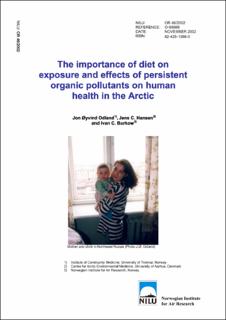| dc.description.abstract | The high levels of organic contaminants in the Arctic have caused serious concern regarding the health conditions of indigenous populations in Arctic areas. The exposure to pollutants through the diet is of central concern and today food safety is essential in daily life in developed countries. The main objective of this study is to describe the importance of diet on exposure and possible health effects of persistent organic pollutants (POPs), based on a literature review. Estimates of effects are difficult, but the combination of improved methodology and selection of risk groups will be a good step further. The most effective abatement strategies are those developed with the affected people strongly engaged in the decision making process. Any strategies based on traditional food substitution should ensure that the value of the dietary components is sustained. It is essential that countries ratify and implement multinational environmental agreements and protocols on POP reduction. Based on current global trends and activities to manage risks, there are likely to be minor decreases in POPs in Arctic populations in Greenland, Eastern Russia, Western Alaska and Eastern Canada by 2010. There are likely to be major decreases in POP levels in the same populations by 2030. Levels of POPs in populations in the Faeroe Islands, Norway, Sweden and Finland are already reasonably low and will possibly only decline marginally by 2030. In order to improve the scientific understanding of health effects associated with contaminant exposure in the Arctic, we recommend that circumpolar epidemiological studies should be implemented in a larger scale. POP related effects are still one of the key issues. Also, the role of the many “new” POPs should be investigated. For exposure assessment, epidemiological studies should consider mixtures of contaminants and nutritional interactions. There is a need for a more nuanced view on human dietary exposure to xenobiotics. Risk should not be evaluated alone, but seen in relation to benefits from specific diets. | |
